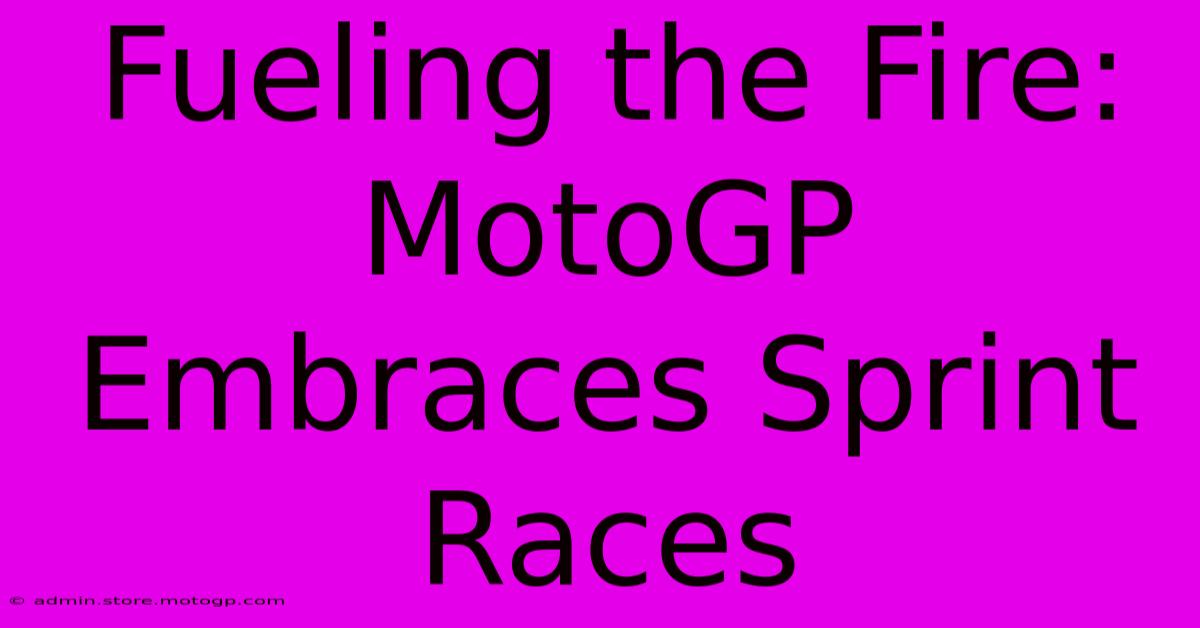Fueling The Fire: MotoGP Embraces Sprint Races

Table of Contents
Fueling the Fire: MotoGP Embraces Sprint Races
MotoGP, the pinnacle of motorcycle racing, has ignited a new chapter with the introduction of sprint races. This bold move has injected a thrilling new dynamic into the sport, sparking debate and excitement among fans and riders alike. But what impact are these shorter, faster races having on the championship, the riders, and the future of MotoGP? Let's delve into the burning question: are sprint races truly fueling the fire, or are they just adding extra fuel to an already intense competition?
The Sprint Race Revolution: A Game Changer?
The addition of sprint races, held on Saturday afternoon before the main Grand Prix on Sunday, has fundamentally altered the weekend format. These shorter races, typically lasting around 12 laps, offer a condensed dose of adrenaline-fueled action. The impact is significant:
Increased Excitement and Fan Engagement:
- More racing, more thrills: The obvious benefit is more on-track action for fans. Two races per weekend means double the opportunities for overtakes, crashes, and dramatic finishes. This translates to higher viewer engagement and more captivating television broadcasts.
- Saturday excitement: Historically, Saturday in MotoGP was largely focused on qualifying. Now, it’s a full day of racing action, boosting attendance at tracks and increasing overall fan engagement.
- Strategic implications: Sprint races introduce a new layer of strategic complexity for teams and riders. The shorter distance means less time for tire management and different approaches to race setup. This adds a further dimension of unpredictability, keeping fans on the edge of their seats.
Impact on the Championship and Riders:
- Championship points implications: Sprint races award championship points, although fewer than the main race. This adds a crucial element of pressure, forcing riders to compete fiercely even in the shorter format. Every point counts, creating a tighter championship battle.
- Physical and mental demands: The increased racing demands more from the riders physically and mentally. The double-race weekend requires exceptional stamina and focus, pushing the boundaries of human endurance.
- Risk versus reward: The increased competitiveness of sprint races means increased risk. Riders might be more inclined to take greater risks, leading to more spectacular overtakes but also a higher chance of accidents.
The Critics' Corner: Addressing the Concerns
While the sprint races have generated considerable excitement, there are also voices of dissent. Some argue that:
Concerns about Rider Fatigue:
- Physical strain: The increased workload could lead to rider fatigue, increasing the risk of accidents and injury. The long-term effects of this intensified racing schedule on rider health are a legitimate concern.
- Impact on the main race: Some believe the sprint race can deplete a rider's energy reserves, potentially affecting their performance in the main Grand Prix on Sunday.
Dilution of the Main Event:
- Diminished importance: There's concern that the main race might lose some of its prestige and significance due to the added emphasis on the sprint race.
- Shift in focus: The increased media attention on sprint races could overshadow the traditional main Grand Prix, altering the balance of the weekend.
The Future of Sprint Races in MotoGP: A Balancing Act
The success of sprint races in MotoGP will depend on striking a balance between increased excitement and rider welfare. Dorma and the teams need to carefully monitor rider fatigue, ensuring their safety and long-term health. Furthermore, a careful analysis of the impact of sprint races on the overall championship narrative is necessary. If the sprint races become too dominant, it could detract from the main event, negating the positive effects.
In conclusion, the introduction of sprint races in MotoGP is a bold experiment that has undeniably injected new energy and excitement into the sport. While concerns exist, the positive aspects, particularly the increased fan engagement and intensified championship battles, strongly suggest that this new format is here to stay, at least for the foreseeable future. The key to long-term success will be ongoing monitoring and careful adjustment to ensure the sport remains both thrilling and sustainable.

Thank you for visiting our website wich cover about Fueling The Fire: MotoGP Embraces Sprint Races. We hope the information provided has been useful to you. Feel free to contact us if you have any questions or need further assistance. See you next time and dont miss to bookmark.
Featured Posts
-
Experience The Speed Motorcycle Race Austin Tx
Feb 20, 2025
-
Yamaha V4 Moto Gp The Thrill Of Competition
Feb 20, 2025
-
Bike Racing On Tv A Global Phenomenon
Feb 20, 2025
-
Cota Track Day Drive Your Dream Car
Feb 20, 2025
-
Cota Shuttle Service Your Race Day Savior
Feb 20, 2025
